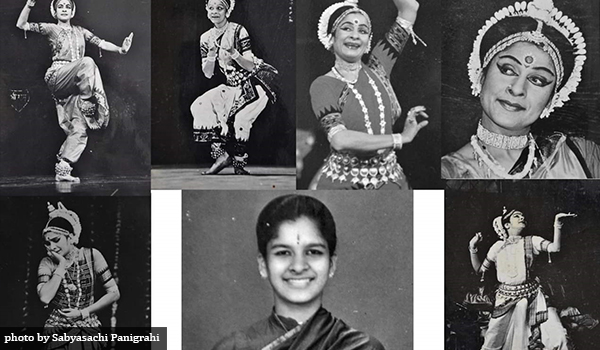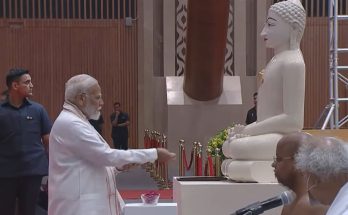By Kedar Mishra
“When I watch Sanjukta Panigrahi dance, it is not merely to observe the displacement of energy in her body or the tensions embodied in her immobility. I am compelled to see and feel how these “physical laws” evoke particular emotion in a specific performative context. The anatomy of the actor is of no use until it is contextualized within an expressive framework. What can it possibly mean otherwise? The bio of the actor becomes significant only in relation to his/her ethos; it cannot be separated from ‘culture, history and style’”. (Page-57, Theatre and the World: Performance and Politics of Culture by Rustom Bharucha.)
To evaluate the art of Sanjukta Panigrahi (August 24, 1944 – June 24, 1997), Odisha’s legendary Odissi dancer, one must look into these three things as Rustom Bharucha outlined “culture, history and style”.
She was the first ambassador who gave a befitting exposure to Odissi culture and style to a global audience. Though the credit of presenting Odissi for the first time in foreign land has duly been credited with Indrani Rahman, it was Sanjukta who truly showcased the soul of Odissi to the world.
Charm of a great dancer
Her passion and perfection created an unattainable height for herself impassable to many of her contemporaries and juniors. She was Sanjukta, one and only. New generation of Odissi lovers who have not seen her perform live can still discover those illuminating glimpses from YouTube or various other digital archives.
The fastest and complicated feet movements in “Yugma Dwandwa Pallavi” came to Sanjukta’s body like a divine possession. Her unique thump on stage was like a poetic signature.
In 1980s, Fritjof Capra, the famous author of Tao and Physics got a chance to see Sanjukta performing in Mumbai along with her great Guru Kelucharan Mohapatra. An ecstatic Capra wrote: “The performance was magnificent. The dancers evoked a ceaseless stream of emotions through a dazzling display of the most refined movements and gestures. Sanjukta’s poses were fascinating. It seemed to me as if the ancient the ancient stone sculptures, had suddenly come alive” (Page- 333, Uncommon Wisdom by Fritjof Capra).
Indeed that was the charm of a great dancer.
A rebel and an innovator
A rebel and an innovator, Sanjukta Panigrahi was born in a Brahmin family and Brahmins in Odisha were not so open for a dancing career. Being a Brahmin and woman, the double hurdles was easy to cross over for Sanjukta with the firm support of her parents Abhiram Mishra and Shakuntala Devi.
From her childhood she was a possessed dancer, passionate and unstoppable. Bishuba Milana Mandap, a grand cultural gathering in Cuttack led by Harekrushna Mahatab, fondly witnessed little Sanjukta dancing nonstop far exceeding time limit. Her mother had to climb up to the stage to stop the girl by force.
That was the passion of her life. She shoulders the life heritage of a renovated dance form and took it to a global platform. Her mentor and Guru Kelucharan Mohapatra taught her the essential techniques of dance and her own imagination and creative vision add impeccable perfection to it.
She learnt Bharatanatyam at the famous Kalakshetra under the guidance of great maestro Rukmini Devi Arundale. Once narrating her learning experience, she said: “I had two gurus, each with contradicting views. While Rukmini Devi Arundale stressed on technique, Guru Kelucharan Mohapatra insisted on forgetting technique. I was confused. Much later I realised that with dedication and hard work, technique would follow automatically.”
Spontaneity of her talent formed many a historical moments and she went beyond a fixed format of scriptural rigidity. It was her body language that could easily speak of divinity. In Ardhanariswara, she intricately displayed the paradoxical and diametrically opposite cosmic visuals. Depicting Iswara and Parvati as the whole of paradoxical union, she unfolded a great philosophical narrative like an abstract painting.
Odissi as an art form got its true global identity through Sanjukta’s performances. Her association with Eugenio Barba, the famous Italian theatre personality and a master innovator, created a masterly project historically known as “Beyond Floating Islands”.
With Barba, Sanjukta got an opportunity to work with Nobel laureate Dario Fo, internationally reputed theatre masters Jacques Lecoq, Jerzy Grotowski and Balinese dancer Djimat. That was the greatest and rarest creative forum where an Odia got a chance to work with.
As a grand master of Indian art, Sanjukta worked with many greats, but it was Raghunath Panigrahi, her lover and husband who remained her greatest companion in life and art. Raghu babu’s voice added charisma to her dancing.
Legacy yet to be nurtured
In her lifetime, Sanjukta got due recognition and led a dignified life. She was a Padma Shri in 1975, at the age of 31. She had received the Sangeet Natak Akademi Award in 1976 with Raghunath Panigrahi. Irony is that Raghunath Panigrahi was conferred on with Padma Shri in 2010, 35 years after Sanjukta received it.
Sanjukta died at the age of 52 in 1997 and the world lost a greate dancer.
Truly speaking, Sanjukta’s legacy has not been properly nurtured by his own people. Organising festival or distributing awards in her name are simple tokenism. To preserve her great legacy and documentation of her life and art is an area of darkness.
We are unable to publish a simple monograph on her life. Her letters, photographs, audio-visual materials, dresses, notebooks….No one can see all these. Many academic articles and interviews of and on Sanjukta are lying scattered. No one is trying to pick them up and compile all those valuable material.
The Odissi Research Center, which has forgotten the word “research”, is no way working for documentation and publication. We have failed to preserve a great artiste’s legacy.
Concluding an essay on the three major Ballet artists, celebrated dance critic James Waring wrote, “The best dancers are translucent. You see through them.”
The translucent personality of Sanjukta Panigrahi must be first seen properly and then shown to generation next with a proper plan.
(Photo credit: Sabysachi Panigrahi)




